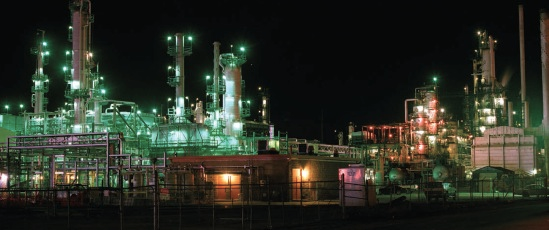Robert Ukeiley June 11, 2015

A massive capital-intensive build-out of petrochemical plants is underway on the Gulf Coast, enabling a huge increase in the amount of oil and natural gas production in the United States. Warren Gretz/NREL Pix 04407
I recently went to a great conference for clean energy advocates, put on by the Institute for Energy Economics and Financial Analysis in New York City. During the conference, I learned what to me was a startling fact—there is approximately $125 billion of petrochemical plant construction going on near the Gulf Coast.
What does this have to do with clean energy? Well, basically everything. Oil and natural gas do not come out of the ground by themselves, they come out with other substances, including natural gas liquids and various other chemicals. The fossil fuel producers need to do something with this “stuff” or they can’t extract the oil and natural gas. Although much of this other stuff ends up as fuels in gasoline or as a fuel itself like pro- pane, a nontrivial and extremely important percent age of it ends up going to the petrochemical industry. Again, without the ability to use these chemicals in the petrochemical industry, the oil and gas can’t be extracted.
But I am not aware of any concerted effort to address this massive capital-intensive build-out of petrochemical plants, which is enabling a huge increase in the amount of oil and natural gas production in the United States. And as we all know, cheap natural gas can make it harder for certain renewable projects to get built, and can also skew the economics against energy efficiency upgrades.
What can be done? Two ideas come to my mind.
I’ve spent the last two decades as a Clean Air Act lawyer, so naturally, that is where my mind goes first. Houston and Dallas, Texas, and parts of Louisiana have a serious ozone problem. Where does ozone come from? It is formed by a reaction between nitrogen oxides (NOx) and volatile organic compounds (VOCs) in the presence of sunlight. Petrochemical plants tend to be large sources of VOCs and sometimes also of NOx. It seems like adding a lot more VOCs and possibly NOx to an area that already has an ozone problem is a really bad idea. Likely, there are Clean Air Act provisions that frown upon such a bad idea, but someone would need to dig into the details to determine if any exist.
The second idea is shareholder action. The petrochemical companies are basically betting the farm that there will be a 20-plus-year stable supply of feedstock from by-products from oil and gas extraction. After all, it takes a good while to recover a $125 billion capital investment.
But there are a lot of other folks who think the current oil and gas boom we are experiencing—largely due to new access to unconventional oil and gas deposits through methods like “fracking”—isn’t going to last anywhere near 20 years. If that is true, then the petrochemical companies are irresponsibly investing their shareholders’ capital in projects that will not pay off. Methods exist, such as shareholder resolutions, to call companies to account when making such large and risky bets.

Robert Ukeiley (rukeiley@igc.org) is a lawyer who represents environmental nonprofits in Clean Air Act litigation affecting energy issues.